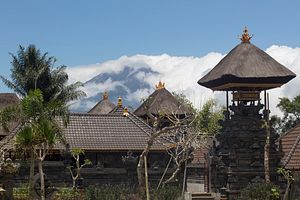Mount Agung, a volcano located on the popular tourist destination island of Bali, rumbles, threatening to erupt for the first time in 54 years. Mount Agung’s last eruption, in March 1963, killed more than 1,500 people but this time the Indonesian government is more prepared and has set an exclusion zone of 12 kilometers around the volcano.
In August, Mount Agung’s volcanic activity increased, prompting the Indonesian government to evacuate more than 140,000 people living in villages located on the slopes of the volcano. They were relocated in 484 temporary shelters spread throughout nine districts and cities in Bali. The size of the temporary shelters varies greatly, from a few dozen people to thousands. The National Disaster Management Agency (BNPB) in cooperation with the Indonesian army, local NGOs and volunteers, handle the needs of the relocated people, from food, sanitation and healthcare to entertainment for children.
Kopernik, a local NGO from Bali has seen a great response to their online relief effort fundraising campaign, managing to raise more than $45,000. The money has been used to deliver thousands of emergency items including hygiene kits, food, blankets, sleeping mats and other critical supplies to the relocated families. “A great number of people in the community have been extremely generous and responsive to supporting the relief effort. Everything we have been able to deliver to the evacuees would not have been possible without the support of the community,” said Ewa Wojkowska, Co-Founder and Chief Operating Officer of Kopernik.
For the evacuees life revolves around spending time in the safety of the camps and tending to the animals and homes left behind in the exclusion area. People have abandoned their belongings and their livestock, which for most of them represent their livelihood. During the day, the men take trips back to their villages to check on their family homes and feed the animals. There are efforts being made to relocate livestock to a safe distance from the volcano. The Ministry of Agriculture in cooperation with local NGOs have relocated more than 20,000 cattle to spaces in the villages that are offering temporary shelters.
Les village, located in Buleleng regency in the north of the island, hosts 2,000 people in its temporary shelter. “With the help of the National Board for Disaster Management and volunteers from NGOs and nearby villages we managed to provide shelter, food and sanitation. We are planning to raise the capacity of the shelter so we can host 5,000 people,” said Gede Susila, head of Les village.
Students from local high schools are volunteering daily to clean up the shelter and organize activities for the children. The relocated children continue their studies, most of them having been enlisted in schools in the temporary camp areas.
At Gor Swecapura, the biggest temporary shelter, located in a sports complex in the Klungkung regency, time passes in an atmosphere of tension and uncertainty. During the day, the men are out trying to relocate their family belongings or working, while their worried wives take care of the children and discuss the anticipated eruption.
Meanwhile, Mount Agung continues to churn, the increasing volcanic activity monitored by the Indonesian Volcanology and Geological Disaster Mitigation Center. An eruption could occur at any time.
Alexandra Radu is a photojournalist based in Kuala Lumpur. Her portfolio is available here.




















































